Promotional Effectiveness Metrics & Email Capture Benchmarks Across 10 Ecommerce Industries [2022 Report]
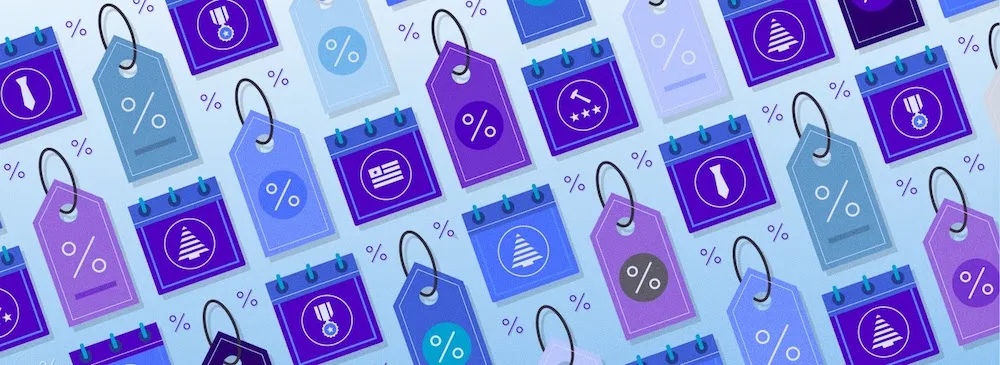
There’s a problem in ecommerce that needs to be addressed, and fast.
Catch-all, batch-and-blast ‘expert’ advice that is not applicable to your business.
Every store is different.
It’s about time we understand that and leverage the data we have to make meaningful changes that increase sales and benefit the different types of businesses out there.
To do that, data to help your individual brand benchmark success and make strategic decisions is crucial.
That’s why combed through hundreds of thousands of data points from our customers over Cyber 5 2017.
Why Cyber 5 data?
It is when the most amount of consumers are shopping online – giving us a wealth of data to sort through for almost all industries
It is also when brands spend an increased amount of time planning and running promotions (likely in the same way they should all year).
These 2 aspects give us a perfect storm of perfect promotional execution and potential engagement volume to understand how promotions affect conversion for 10 different industries:
Let’s address first things first…
What is Promotional Marketing?
Promotional marketing is the use of incentivisation to drive a consumer to take a certain action to increase a brand’s awareness, generate sales or create brand loyalty.
Promotional marketing messaging can include:
Discounts on a purchase.
Free products for an email signup.
Online retailers leverage promotional marketing in many ways to drive their on-site visitors to take an action that benefits their business.
How to Measure Promotional Lift:
Promotional lift is the percentage increase in sales or site traffic attributed to a promotional campaign.
Promotional lift is measured by calculating the percent change in sales or traffic between a regular (non-promotional) time frame for the business versus a the promotional time period.
For instance, if you ran a week long campaign that produced 2,168 sales, versus a regular week when you get 1,006 sales on average, your promotional lift is 115.51%.
Here is the 2-step formula:
Increase = New Number – Original Number
% increase = Increase ÷ Original Number × 100.
Now, before we dive into the actual numbers, let’s first make sure we are all on the same page about how we define the promotion lift metrics.
In this study, we looked at 3 metrics for our promotional lift calculations:
Conversion rate without promotions.
Engaged conversion rate with the promotion.
The percent change between those two numbers.
Let’s take a look.
1. Conversion rate (CVR).
Conversion Rate (CVR) refers to the percentage of visitors to a website who resulted in a sale.
This population is segmented down to visitors who did NOT interact with a Justuno promotion and still completed a purchase.
For the Furniture industry, 0.63% of on-site visitors did NOT interact with a promotion but ultimately still resulted in a sale.
However, 2.17% of on-site visitors who did interact with a Justuno promotion resulted in a sale. That’s a 244.44% increase in conversions.
2. Engaged conversion rate (CVR).
Engaged Conversion Rate (Engaged CVR) is referring to exactly that, the percentage of on-site visitors who interacted with a Justuno promotion and completed a purchase.
3. Calculate percent change of CVR vs engaged CVR.
The % Change effectively is the difference between a normal visitor’s rate of conversion as opposed to the rate of conversion of a visitor who interacts (engages) with a Justuno promotion.
Here’s how these two stats breakdown by industry in our study.

Promotional Effectiveness & Lift Benchmarks
The goal of the study was to understand what affect offering promotions on your site has on conversion rate.
Moreover, we wanted to break that down by ecommerce industry.
After all, the conversion rate improvement (or not) for an online furniture store’s promotion versus a health and beauty store will be vastly different.
And for store owners and marketers, those differences help you weigh the benefits to running such a promotion –– or sticking with your no-discount guns.
As it turns out, every single industry we looked at saw measurable and impactful conversion rate lift from running promotions.
Here’s how that broke down.
Promotional Effectiveness Overview by Industry
Industry
Conversion Rate
Engaged Conversion Rate
Percent Change / Lift
Arts & Entertainment
2.53%
5.95%
135.18%
Beauty
2.65%
6.60%
149.06%
Children
3.58%
15.98%
246.37%
Clothing
2.19%
7.25%
231.05%
Food & Grocery
2.05%
5.60%
173.17%
Furniture
0.63%
2.17%
244.44%
Health
0.40%
12.16%
3150%
Home & Garden
1.40%
10.02%
615.71%
Jewellery
1.04%
5.50%
428.85%
Marketing & Advertising
1.88%
7.62%
205.32%
Marketplaces
3.55%
8.62%
142.82%
Sports
1.15%
7.34%
538.26%
Click here to see a PDF version of this chart.
Email Capture Rate Benchmarks
In addition to looking at conversion rate improvements due to promotional activities across industries, we also did a deep dive on email capture rates.
This is because the size and engagement of your email list is a crucial piece of the growth puzzle in ecommerce.
Sure, Amazon can get you tons of sales. But you don’t get a single email address.
But on your own website, you can not make a sale and still get an email address.
Why is that important?
Because then you no longer have to pay to talk to that person – assuming they are engaged with your email.
And even if they aren’t, you can now begin to retarget and remarket both to that email address as well as to their friends and family through lookalike audiences on Facebook.
All in all, how many emails you can capture is important.
So, we wanted to know:
Does offering a promotion to nab an email address increase conversion rate on email capture forms?
That answer was also decidedly YES.
Here’s how that broke down.
Email Capture Overview by Industry
Industry
Average Email Capture Conversion Rate
Arts & Entertainment
1.19%
Beauty
4.15%
Children
3.41%
Clothing
5.66%
Food & Grocery
2.56%
Furniture
2.74%
Health
2.99%
Home & Garden
2.16%
Jewellery
6.77%
Marketing & Advertising
4.08%
Marketplaces
2.17%
Sports
2.62%
Click here to see a PDF version of this chart.
Promotional Effectiveness & Email Capture Rates by Industry
OK. Let’s get into the meat of it.
Below, we’ll break down exact metrics and show examples across various ecommerce industries, including:
And for each vertical, we’ll look at:
Average conversion rate without a promotion
Promotional conversion rate Benchmarks
Email capture benchmarks
Here we go.
Related Reads
The 6 Most Effective Types of Social Media Advertising in 2018
49 Tips & Strategies for Successful Holiday Marketing Campaigns
1,018 Brands Disclose Their Holiday Ecommerce Plans: How Do You Stack Up?
Arts and Entertainment Promotional Effectiveness Benchmarks
Average Conversion rate: 2.53%
Conversion rate with promotion: 5.95%
Email capture conversion rate: 6.3%
The arts and entertainment ecommerce industry comprises:
Musics
Audio
Photography
Visual arts
Design stores.
This industry has a relatively high conversion rate already at 2.53%, without the use of promotional marketing.
However, that conversion rate increased 2X, to 5.95%, after leveraging promotional marketing on-site.
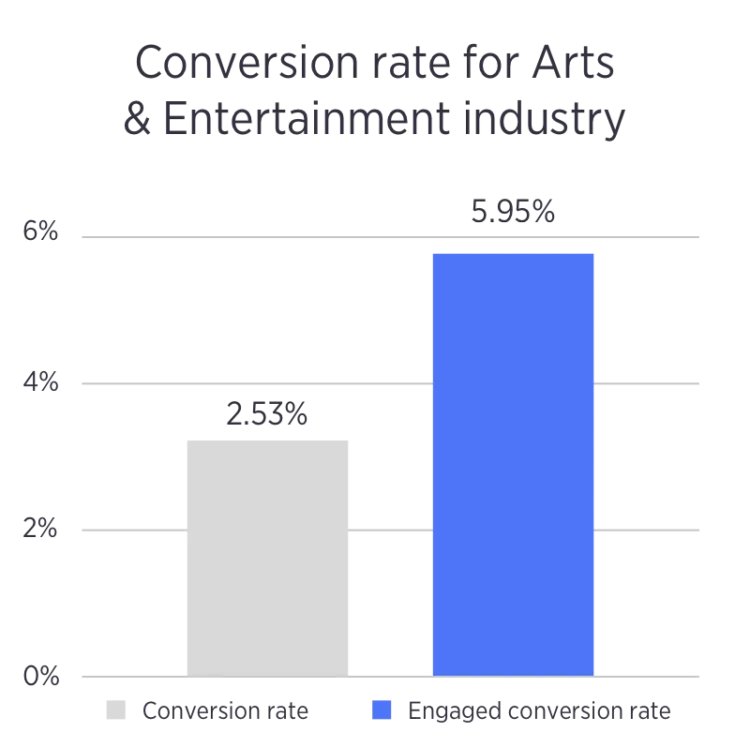
The most successful promotional strategy for retailers in this industry was a discount offering for an email address.
Site visitors converted with this promotion at 6.3%.
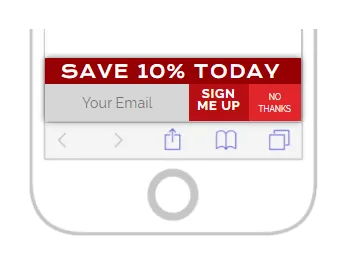
Email capture bars like this are also useful for avoiding pop-ups, which can be penalised by Google and hurt your SEO rankings.
These are particularly effective on mobile devices.
Beauty Industry Promotional Effectiveness Benchmarks
Average Conversion rate: 2.65%
Conversion rate with promotion: 6.60%
Email capture conversion rate: 10.47% for Skin Care, 5.2% for Beauty & Fitness.
Conversion rates for the beauty industry increased almost 4X for retailers using promotion.
Without promotions, conversions were 2.65% on average for the industry.
With conversions, that spiked to 6.60% on average.
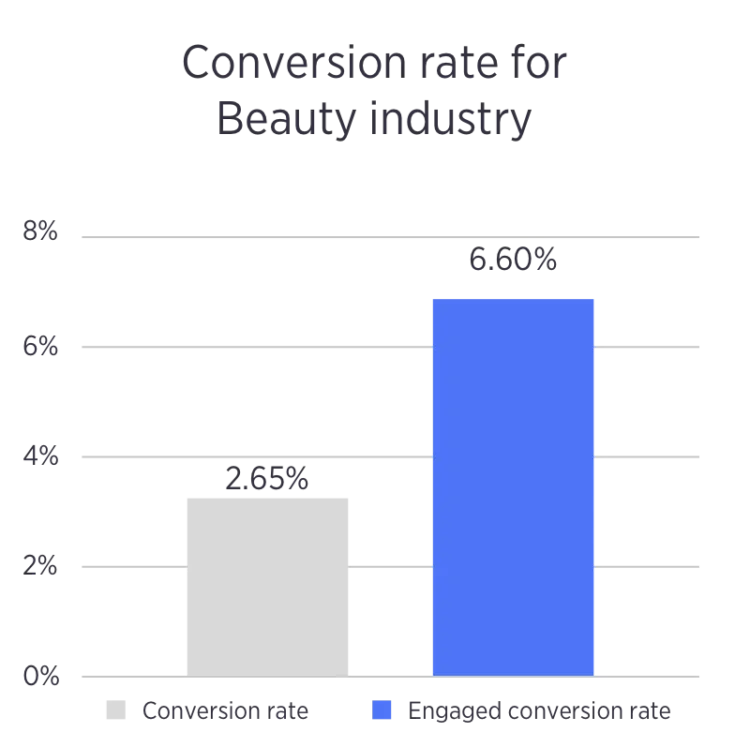
The Beauty Industry itself had email capture rates noted at:
10.47% for Skin Care
5.2% for Beauty and Fitness
Above average engagement rates at 10.47% and 5.2% indicate that on-site visitors of this niche enjoy email marketing from these retailers.
This indicates that promotional marketing with the intent of email capture performs very well. Take the promotion below, for example.
Beauty Bridge offered 20% off for an email capture.
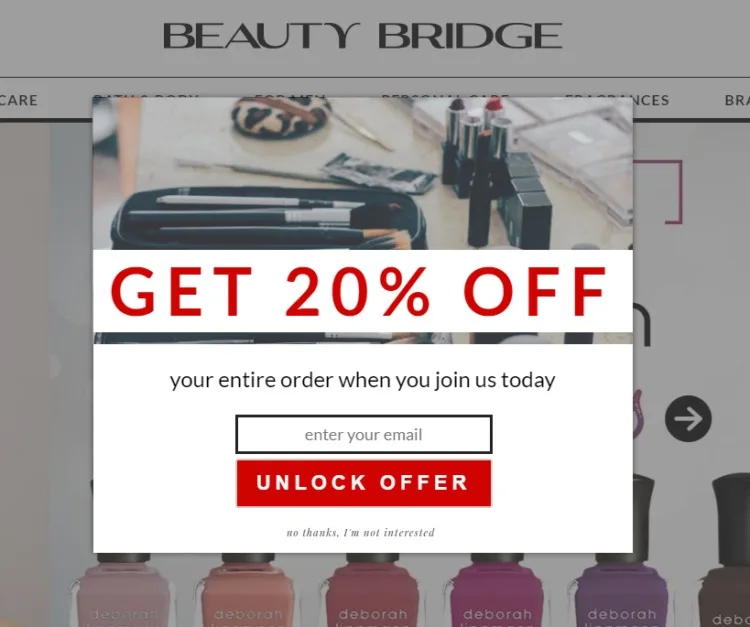
Promotions like this see up to a 16.2% conversion rate after opt-in for the beauty industry!
Jewellery Industry Promotional Effectiveness Benchmarks
Average Conversion rate: 1.04%
Conversion rate with promotion: 5.50%
Email capture conversion rate: 8.08%
The jewellery industry in ecommerce holds includes websites such as Watches.com and Fossil.
The average conversion rate for jewellery brands starts out fairly below average at 1.04%.
After the use of promotional marketing, conversion rates jump to 5.50% on average – a 4.45X increase.
The jewellery industry has email capture rates at 8.08%. Offer a discount promotion for lead capture increases this almost 6X.
This watches.com promotion in particular performed at a 13.9% impression to engagement rate, capturing thousands of emails during the BF/CM rush.
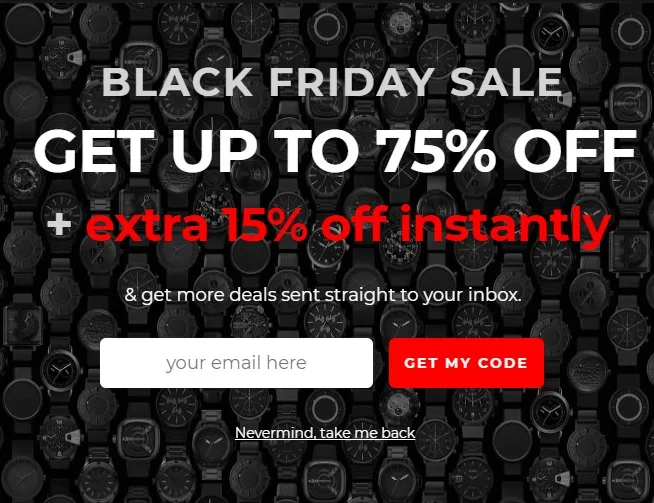
A common trend noticed during the BF/CM weekend is that the benefits of promotional marketing are only amplified by increased traffic and on-site visitors.
Home and Garden Promotional Effectiveness Benchmarks
Average Conversion rate: 1.04%
Conversion rate with promotion: 10.02%
Email capture conversion rate: 10.8%
The Home and Garden industry has a low base average conversion rate for non-engaged visitors at 1.40%.
However, the increase is significant post engagement with promotional marketing, jumping up to 10.02%!
That’s an 8.6X increase.

Here’s a quick example to really drive this vision home.
Half Price Drapes ran a promotion during the BF/CM time frame and saw a 10.8% engagement to conversion rate with a two-step mobile promotion.
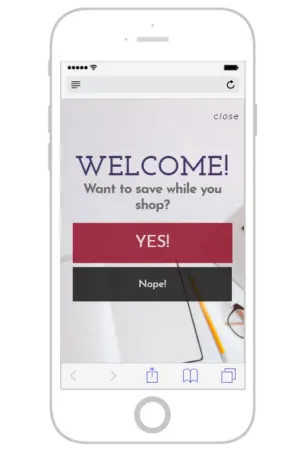

The above promotion collected emails at a 17.54% engagement rate during the weekend, meaning almost 1 out of 5 visitors opted into the promotion for the possibility of an immediate conversion or later email lifecycle marketing.
Leveraging increased mobile traffic (BigCommerce saw mobile orders surpass 50%) nets huge benefits for the Home and Garden industry, not only for email marketing, but for same session sales as well.
Health Industry Promotional Effectiveness Benchmarks
Average Conversion rate: .4%
Conversion rate with promotion: 12.16%
Email capture conversion rate: 6.91%
The Health Industry boasts the biggest increase in conversion rate after using promotional marketing.
This is in part due to the fact that the average conversion rate for non-engaged visitors begins low (at 0.40%).
This increases drastically to 12.16% after promotions, making promotional marketing an enormous benefit to online retailers in the Health industry.
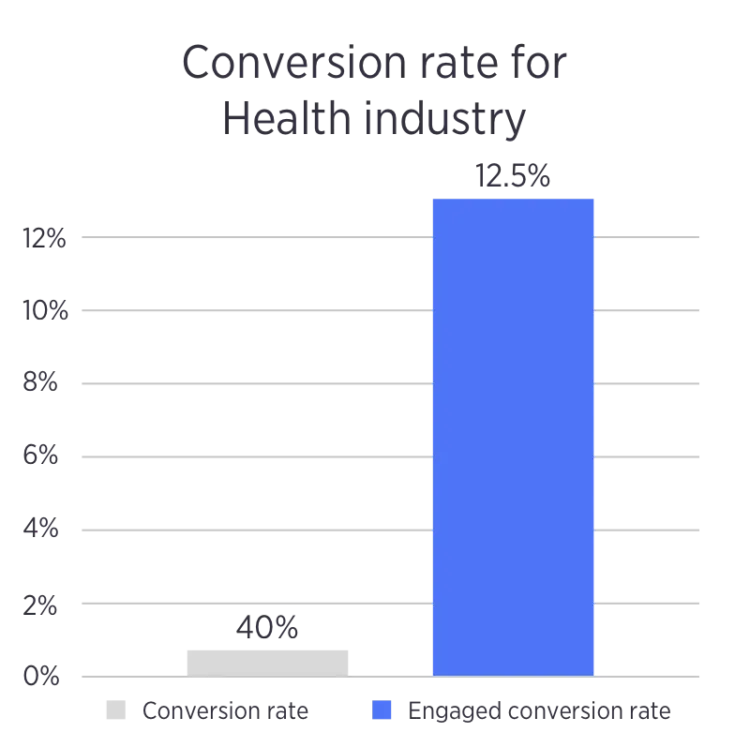
Green Virgin Products utilises an animated exit intent promotion to incentivise on-site visitors back from leaving the site.
This type of promotional marketing can win back visitors who could have otherwise left and never resulted in a sale to begin with.
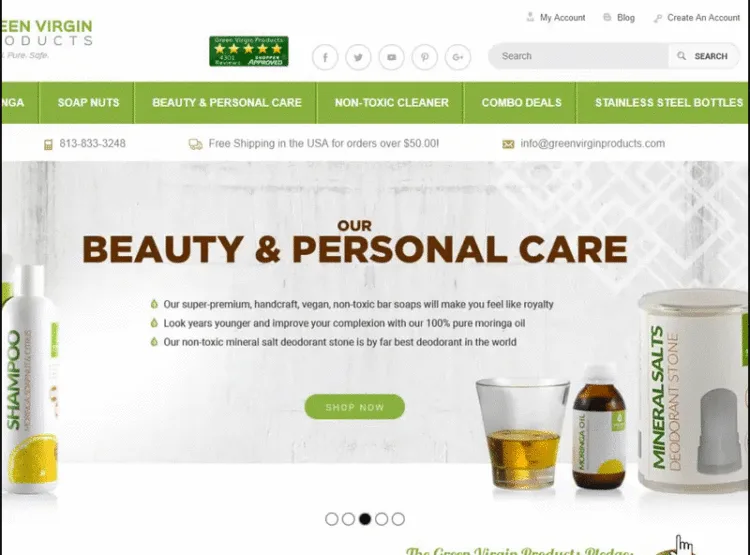
A key tactic used often with promotional marketing and exit intent is the idea of scarcity and urgency.
Driving sales with promotional marketing benefits exponentially when a sense of immediacy is invoked.
Email engagement rate for the health industry was 6.91%, an above average email capture rate.
Food and Grocery Promotional Effectiveness Benchmarks
Average Conversion rate: 2.05%
Conversion rate with promotion: 5.60%
Email capture conversion rate: 28.85%
The Food and Grocery industry is a large and rapidly growing industry. In 2017, sales amounted to $14.2 billion, and are expected to rise to $30 billion by the end of 2018.
With such rapid growth expected, retailers in this niche should maximise proven digital marketing strategies for cultivation.
Food and Grocery retailers using promotional marketing experienced a lift from 2.05% to 5.60%, leveraging strategies such as exit intent to increase retention for on-site visitors.
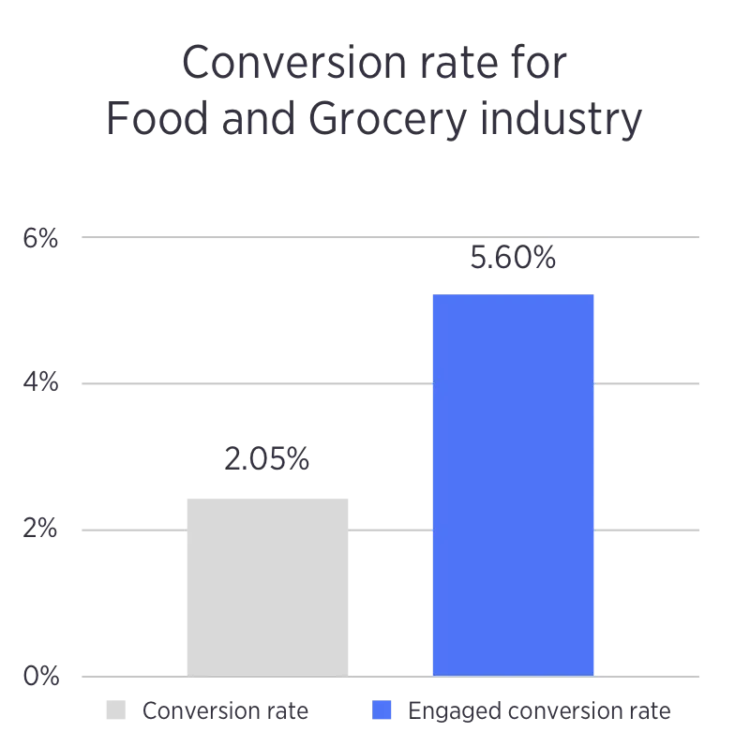
The Liquor Barn leverages the exit intent strategy to gently incentivise visitors who are leaving without purchasing using a 5% discount on their order.
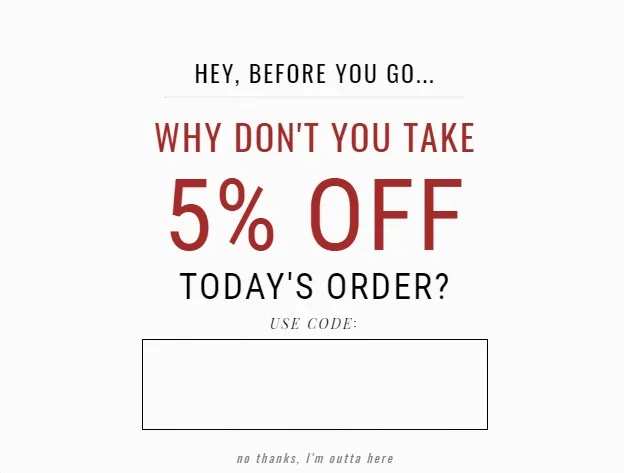
Percentage discounts used for promotional marketing can vary and should be tested thoroughly to provide maximum benefit for a business and it’s on-site visitors.
The Food and Grocery industry averaged a 28.85% email engagement rate, meaning for email popups, 3/10 visitors opted in.
Clothing & Apparel Promotional Effectiveness Benchmarks
Average Conversion rate: 2.19%
Conversion rate with promotion: 7.25%
Email capture conversion rate: 18.83%
The Clothing industry is an enormous market, accounting for 43% of all online marketplace purchases.
Almost half of all purchases in this vertical are made in popular marketplaces such as Amazon.and eBay.
Promotional marketing helped leverage an increase in CVR from 2.19% to 7.25%, a whole 5 percentage points for the better.
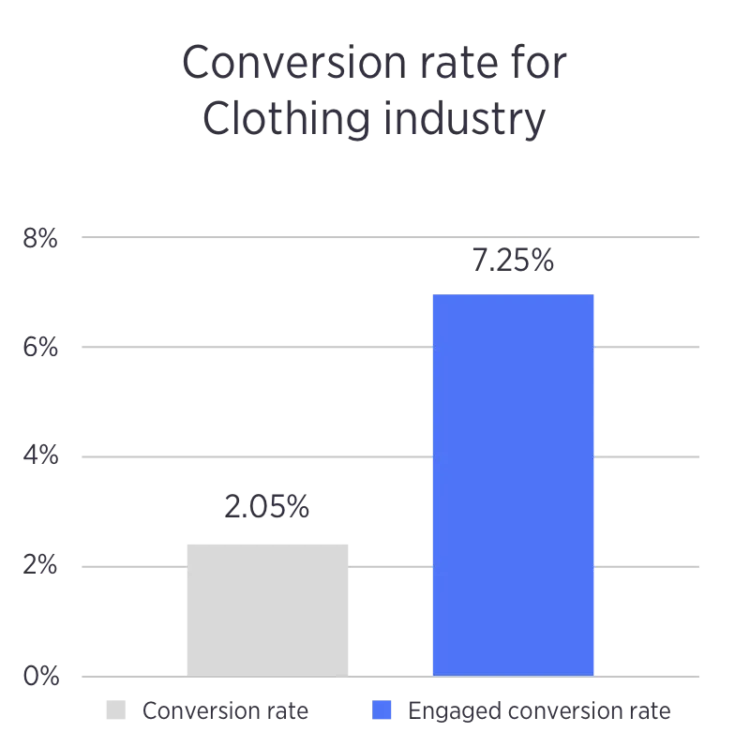
Retailers in this space should leverage exit intent as well as contests to increase email sign-ups and immediate conversions.

Mentalfloss, for example, ran contest sign ups, a great promotional marketing tactic, to collect thousands of emails from on-site visitors.
Contests have the benefit of opening up the possibility of email lifecycle marketing (traditionally the highest form of ROI) as well as engaging a visitor that would otherwise bounce.
For the Clothing & Apparel industry, Email Capture Rate is an astounding 18.83%, making email popups a must have for retailers in this space!
Shopping & Large Marketplace Promotional Effectiveness Benchmarks
Average Conversion rate: 3.55%
Conversion rate with promotion: 8.62%
Email capture conversion rate: 16.14%
Shopping is a broad industry that encompasses websites such as Amazon, Etsy and large, general marketplaces.
If your store has a wide array of products, working off of the data presented in the Shopping industry would be a great step for you and your business.
The CVR change noticed with the use of promotional marketing was more than a 5% increase in conversions.
The Shopping industry itself already has a high CVR (3.55%) without the use of promotional marketing, but leveraging this tactic increases sales more than double!
With promotional efforts, conversion rate increased to 8.62%.
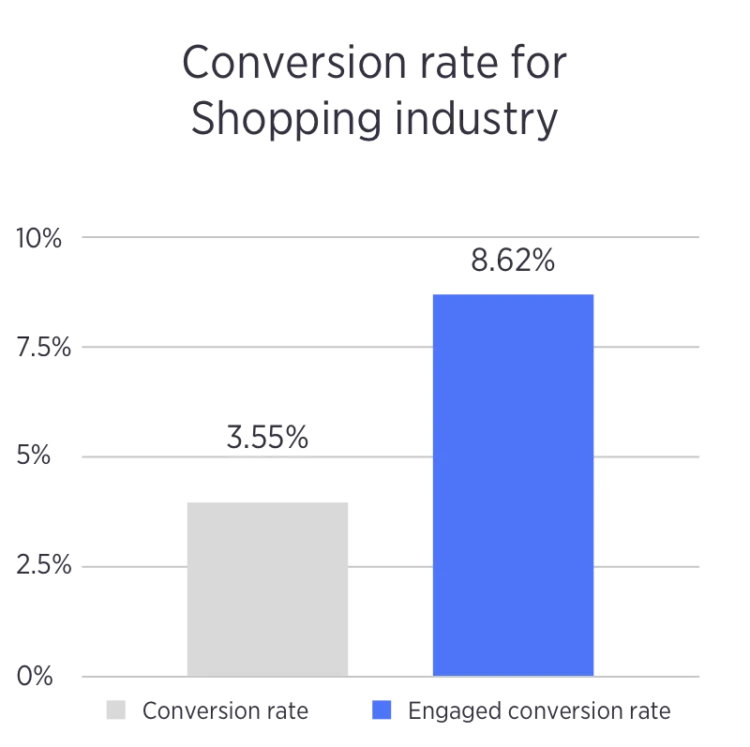
Popular retailer Serengetee leverages the use of contests alongside promotional marketing to engage potential customers and merge them into digital marketing workflows.
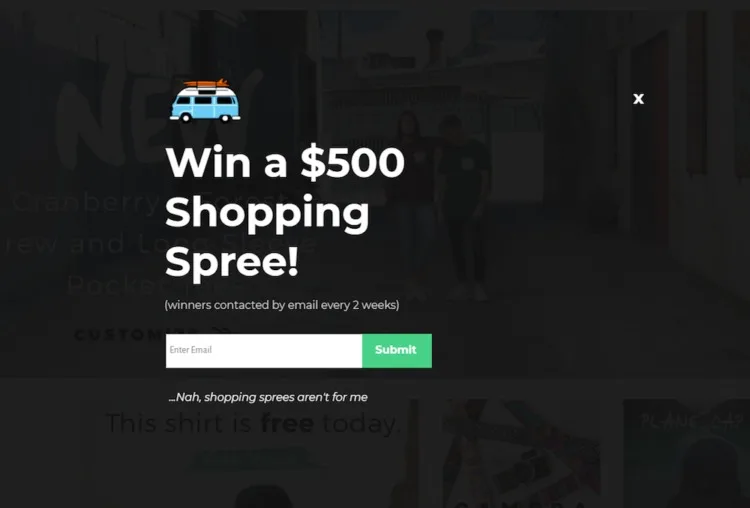
Email engagement rate for the Shopping industry was observed at 16.14% when interacting with an email popup.
Serengetee appeals to a younger audience, who are very receptive to email marketing, and benefits intensely from promotional marketing that focuses on supporting other digital marketing efforts such as email.
Sports & Outdoors Promotional Effectiveness Benchmarks
Average Conversion rate: 1.15%
Conversion rate with promotion: 7.34%
Email capture conversion rate: 2.62%
The increase in sales conversions after the use of promotional marketing is very significant in the sports industry.
Post engagement with promotions, accounts in the sport industry experienced an increase from 1.15% to 7.34%, a significant raise in what would be an otherwise average conversion rate.
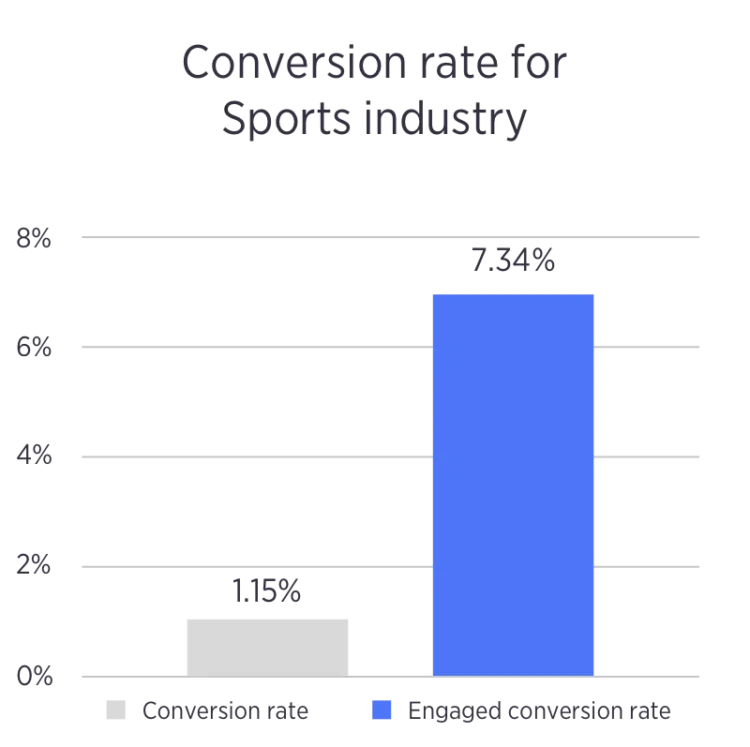
Online retailers such as Gameday Sports Memorabilia leverage promotional marketing by way of ‘cart abandoner promotions’ to increase conversions.
Cart abandoner promotions are behaviourally triggered, based on when an on-site visitor attempts to leave the site with a product in their cart, and factors such as cart value, specific products, etc.
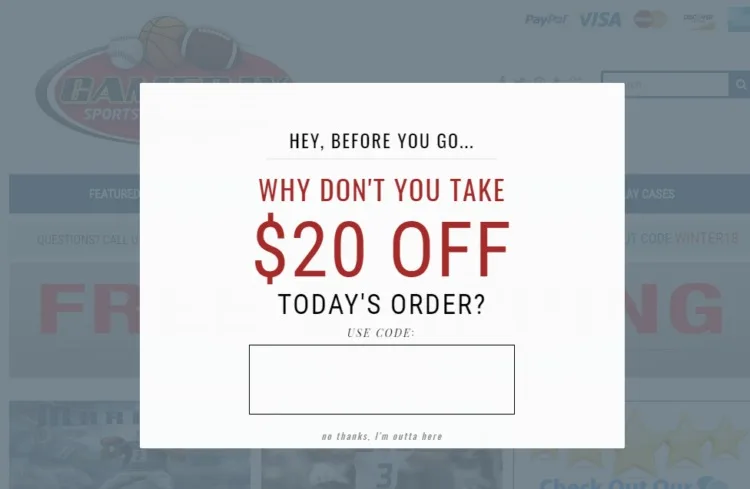
Promotions then incentivise visitors to remain on-site and complete their purchase with an offering of some sort, in this case $20 is offered.
Utilising a dollar amount instead of a percentage discount can often increase conversions due to consumer psychology, but as always, A/B testing your findings is recommended.
Pro Tip
A/B testing a flat dollar amount offering vs. a percentage discount can provide insight into what performs best for your audience.
Children’s Goods Promotional Effectiveness Benchmarks
Average Conversion rate: 3.58%
Conversion rate with promotion: 15.98%
Email capture conversion rate: 3.58%
Increase in CVR for the Children’s Shopping industry is very significant, with average CVR increasing from 3.58% all the way up to 15.98%.
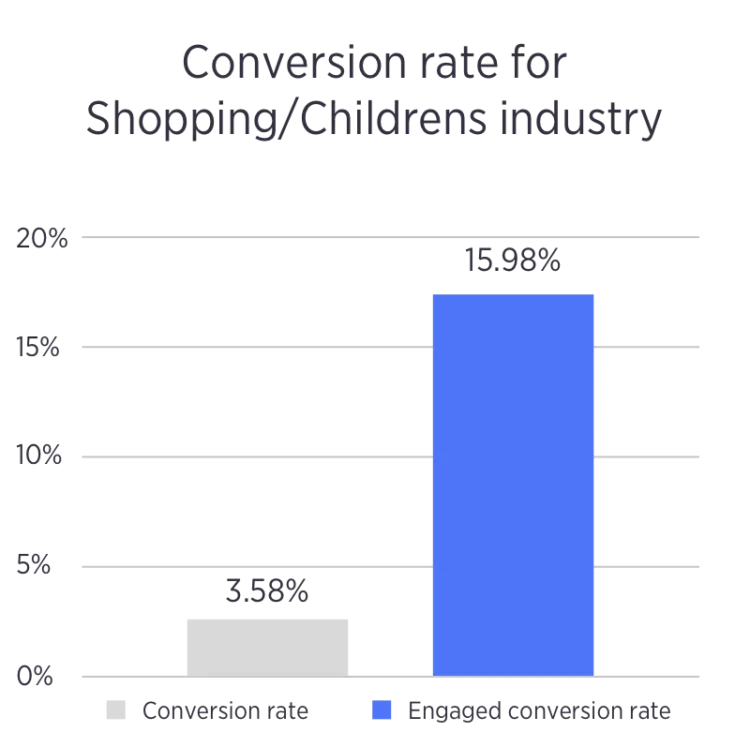
A sharp difference in between normal CVR and an Engaged CVR can point to a promotion-receptive audience.
On-site visitors that are promotion receptive are actively looking for deals or incentivisation, and when offered it, are much more inclined to complete a purchase.
Email engagement rates are at 3.58% for the Shopping/Children industry, so leveraging promotional marketing for email capture is a very viable strategy to build lists.
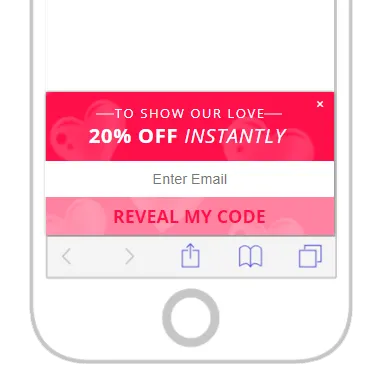
Popular website such as Robeez leverage email signup bars to incentivise visitors to exchange their emails for a percentage discount on an online order.
As examined previously, the Children’s Shopping industry is examined to have promotion-receptive visitors so the use of an email signup bar can open up opportunities for immediate and more ‘lifecycle’ conversions post purchase.
Executive Summary
Examine your industry’s benchmarks for average conversion rate, conversion with promotion and email capture conversion.
Your goal should be to beat the benchmarks.
Benchmarks such as this give you a window to work towards or applaud yourself for.
Your promotions, list building and email marketing are all important strategies to building your customer base, your repeat customer list and your online community.
Special Thanks
Special thanks to Harry from the Justuno dev team for helping to pulli so much insightful data! He ran a ton of SQL queries to really hone the data in. This wouldn’t be possible without you!
Don’t see your industry listed here? Tweet us at @justunosocial and ask for some insights!

Ben works as a Demand Marketing Specialist at Justuno, where he applies his love of copywriting and brand stories to create marketing pieces that impart value to online retailers. He's a firm believer in data to help entrepreneurs build their brands, and ecommerce managers and marketers build their careers. He is a lover of IPAs, indie-rock and marketing. Some call him a millennial in denial.


